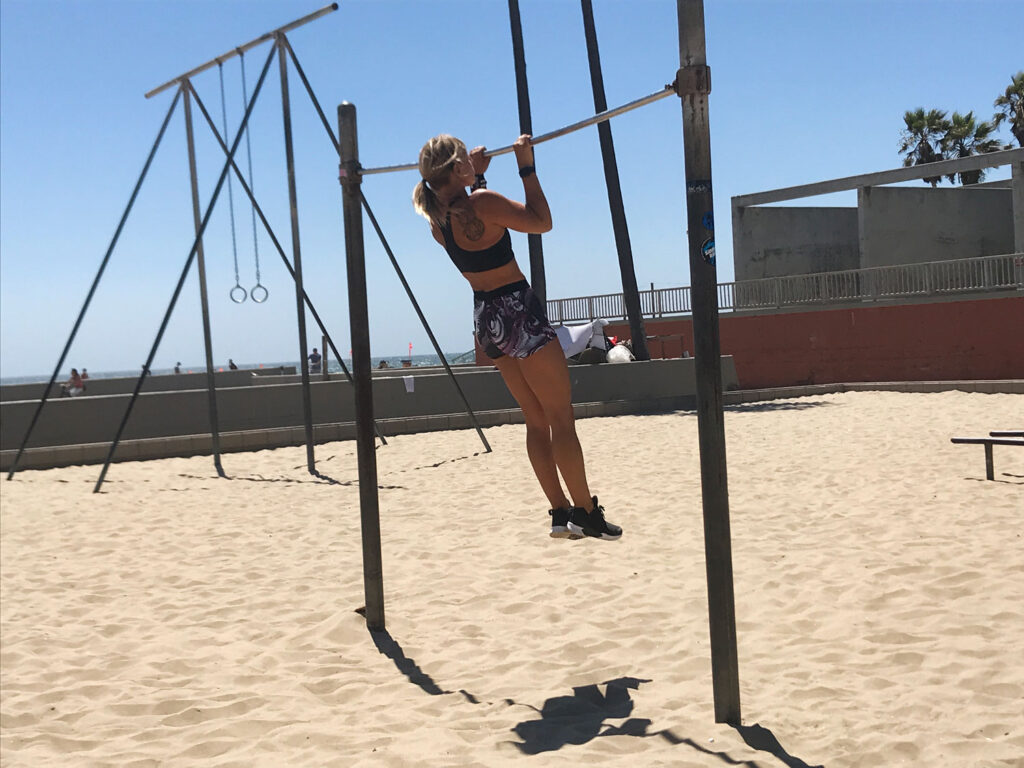
Have you always wanted to be able to do a pull-up?
Pull-ups are one of the most impressive and effective bodyweight exercises, but they’re also one of the most challenging. It took me ages when I was first starting out to be able to do my first one — and I felt like a superhero once I did!
So many people turn to assisted pull-up machines at the gym to work towards their goal, but here’s the hard truth: In my 15 years in fitness, I’ve never seen anyone go from assisted pull-up to actual pull-up.
If you really want to conquer that pull-up bar, it’s time to ditch the machines and start focusing on exercises that build real, functional strength. Here’s how you can get there:
1. Flex Hangs
Flex hangs are a fantastic way to build the strength and endurance needed for pull-ups. Here’s how to do them:
- Start at the top: Use a step or jump to get yourself to the top position of a pull-up, with your chin above the bar.
- Hold: Engage your core, squeeze your glutes, and hold this position for as long as you can. Aim for at least 10 seconds, but if you’re just starting out, even a few seconds will be beneficial.
Why it works: Flex hangs build isometric strength in your upper body, particularly in your biceps, shoulders, and back—exactly where you need it to master pull-ups.
2. Hanging Shoulder Shrugs
Hanging shoulder shrugs are a deceptively simple exercise that targets the often-neglected muscles involved in pull-ups. Here’s how to do them:
- Hang from the bar: Grab a pull-up bar with an overhand grip, letting your body hang fully extended.
- Shrug: Without bending your elbows, engage your shoulder blades and pull them down. You should feel your shoulders rise slightly towards your ears and then depress as you engage your back muscles.
- Relax and repeat: Return to a fully relaxed shoulder position before repeating the movement.
Why it works: This exercise strengthens the scapular muscles, which are crucial for the initial pull-up motion. It also improves shoulder stability, reducing the risk of injury as you work towards full pull-ups.
3. Negatives
Negative pull-ups are one of the most effective exercises to build the strength needed for a full pull-up. Here’s how to do them:
- Start at the top: Just like with flex hangs, jump or step up to the top of the pull-up bar with your chin above the bar.
- Lower slowly: Instead of holding, begin to lower your body as slowly as possible. Aim for at least 10 seconds to descend fully.
- Focus on control: The slower you go, the more muscle fibers you’ll recruit, which leads to greater strength gains.
Why it works: Negative pull-ups focus on the eccentric phase of the movement, which is where you can build the most strength. They’re essential for building the pulling power needed to complete a full pull-up.
See it in action in this short video below:
View this post on Instagram
Example Pull-Up Workout
Here’s an example of how you might put together a workout based on the above exercises:
Complete 3 rounds, resting 1-2 minutes between sets:
- 1 flex hang for max time
- 10 hanging shoulder shrugs
- 3-5 super slow pull-up negatives
Get more pull-up workouts in the 12 Minute Athlete app!
Final Tips: Consistency and Patience to Get Your First Pull-Up
Building the strength to do a pull-up doesn’t happen overnight, but with consistent effort and the right exercises, you can get there. Aim to incorporate these exercises into your routine 2-3 times per week, gradually increasing the duration and intensity as you get stronger.
Remember, progress might be slow at first, but every rep brings you one step closer to achieving your goal. Stay focused, stay consistent, and soon you’ll be able to do pull-ups with confidence.
Ready to ditch the machines and finally achieve that pull-up? Start incorporating these exercises into your routine today, and watch your strength skyrocket!


